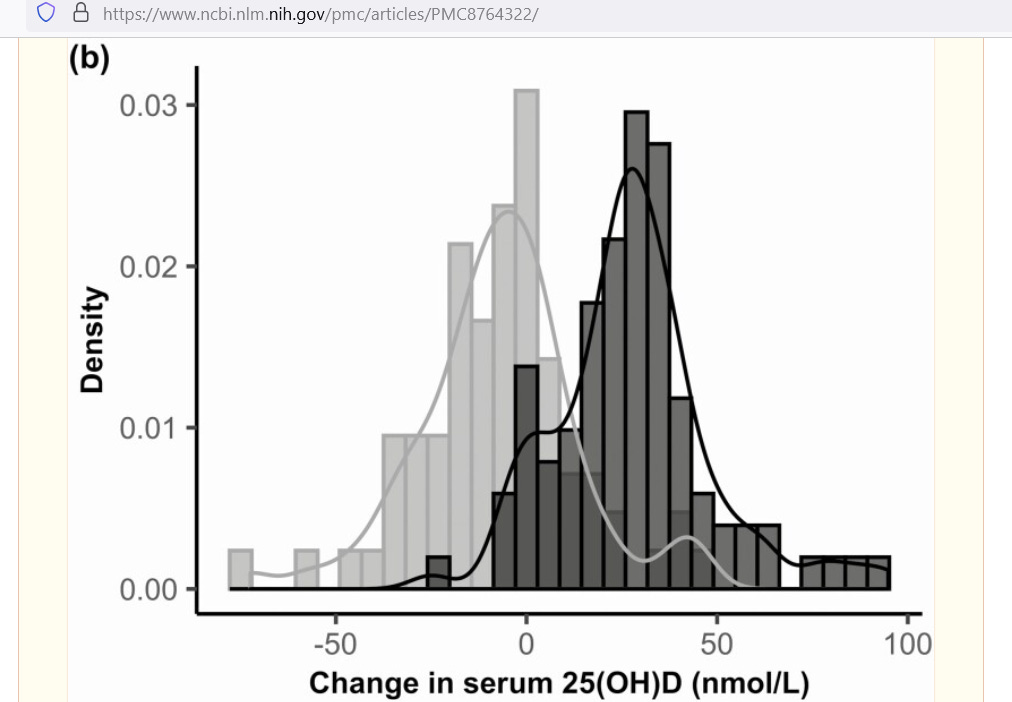Researchers trying to explain flu seasons — and the seasonality of all-cause mortality in general, or of respiratory mortality specifically — often end up citing cold temperatures as being a predominant cause of the temporal increase in disease and death. The largest share of the excess of winter mortality is from respiratory mortality.
But a more-likely cause behind the seasonal fluctuation of disease and death, and of respiratory mortality and even of all-cause mortality, is our vitamin D level — which is kept high during Summer but dips low during Winter:
To this graph, a thinner arrow might be added to extend out from the “Cold & Dry” state to show it connecting to death directly — by way of causing hypothermia or by other paths — and a dotted arrow could be added to infections showing that it can increase the stability of viral aerosols (airborne particles containing a virus such as flu).
I left those arrows out to accentuate the predominant effect of a changing immune level, largely due to lowered levels of active vitamin D during and shortly after a winter season. The direct line from low vitamin D to death is to show all-cause mortality going up by way of low vitamin D, but not through respiratory infections.
The excess winter mortality found among nations curiously peaks in those nations almost halfway from the equator to the poles (at almost 40 degrees latitude):
Researchers tend to explain that as being due to the middle-latitude nations not being cold-adapted but a better explanation has to due with being “Sun-adapted” — because annual fluctuation in vitamin D levels is expected to be the greatest when far from the equator or far from the poles. In mid-latitude nations, large swings in D are expected.
Because excess winter mortality is an excess using deaths during non-winter months as the baseline, the greater the seasonal shift in vitamin D production due to sunlight — with Summer D levels being protective and Winter D levels being harmful — the greater the “excess.”
It doesn’t matter as much if you are exposed to viruses, what matters more is whether you are immune to the viruses you are exposed to. Your immune systems gets “the final say” over whether you will become sick or not from any given exposure. The main reason that we’ve been getting “seasonally-sick” is due to vitamin D levels.
At bottom in the references is a quote showing how it was that risk of all-cause death began to increase after levels of active vitamin D dipped below 90 nmol/L, but to see how much vitamin D might be required to “fix” winter mortality, have a look at two years of supplementation with 2,000 IU of vitamin D in 161 adults with type 2 diabetes:
Even after two years of 2,000 IU per day of vitamin D, pretty much everyone was still below 90 nmol/L — and therefore at increased risk of all-cause death from low physiological levels of active vitamin D, or 25-hydroxyvitamin D (“25(OH)D”). This means that national guidelines telling you to get 600 IU of vitamin D aren’t enough.
The worldwide lack of healthy vitamin D levels explains the seasonality of death better than any other hypothesis does. It is the “best explanation” for seasonality.
Reference
Suulamo U, Remes H, Tarkiainen L, Murphy M, Martikainen P. Excess winter mortality in Finland, 1971-2019: a register-based study on long-term trends and effect modification by sociodemographic characteristics and pre-existing health conditions. BMJ Open. 2024 Feb 2;14(2):e079471. doi: 10.1136/bmjopen-2023-079471. PMID: 38309756; PMCID: PMC10840061. https://www.ncbi.nlm.nih.gov/pmc/articles/PMC10840061/
Jones RP, Ponomarenko A. Trends in Excess Winter Mortality (EWM) from 1900/01 to 2019/20-Evidence for a Complex System of Multiple Long-Term Trends. Int J Environ Res Public Health. 2022 Mar 14;19(6):3407. doi: 10.3390/ijerph19063407. PMID: 35329098; PMCID: PMC8953800. https://www.ncbi.nlm.nih.gov/pmc/articles/PMC8953800/
Jones RP. Excess Winter Mortality (EWM) as a Dynamic Forensic Tool: Where, When, Which Conditions, Gender, Ethnicity and Age. Int J Environ Res Public Health. 2021 Feb 23;18(4):2161. doi: 10.3390/ijerph18042161. PMID: 33672133; PMCID: PMC7926905. https://www.ncbi.nlm.nih.gov/pmc/articles/PMC7926905/
Best CM, Zelnick LR, Thummel KE, Hsu S, Limonte C, Thadhani R, Sesso HD, Manson JE, Buring JE, Mora S, Lee IM, Cook NR, Friedenberg G, Luttmann-Gibson H, de Boer IH, Hoofnagle AN. Serum Vitamin D: Correlates of Baseline Concentration and Response to Supplementation in VITAL-DKD. J Clin Endocrinol Metab. 2022 Jan 18;107(2):525-537. doi: 10.1210/clinem/dgab693. PMID: 34543425; PMCID: PMC8764322. https://www.ncbi.nlm.nih.gov/pmc/articles/PMC8764322/
Heath AK, Kim IY, Hodge AM, English DR, Muller DC. Vitamin D Status and Mortality: A Systematic Review of Observational Studies. Int J Environ Res Public Health. 2019 Jan 29;16(3):383. doi: 10.3390/ijerph16030383. PMID: 30700025; PMCID: PMC6388383. https://www.ncbi.nlm.nih.gov/pmc/articles/PMC6388383/
“Meta-analyses have also found evidence of a non-linear dose-response relationship, with one revealing a plateau in the association for 25(OH)D above 90 nmol/L [2].”
...
“There is strong evidence that vitamin D status is inversely associated with all-cause mortality.”
NOTE: The above mortality benefit plateau at 90 nmol/L is equivalent to 36 ng/mL, meaning that levels below 36 ng/mL led to increased risk of death.





Is there information about population-level vitamin D supplementation (in milk or margarine or whatever) in high-latitude countries? I remember discussing this with people from Scandinavia at some point in 2022.
How do we explain Summer mortality peaks in lower latitudes? While I can agree w fluctuating immune function being a driver of illness, it wouldn’t seem to explain Summer peaks in hot regions. Low vitD due to hiding from the heat? Is that even plausible?